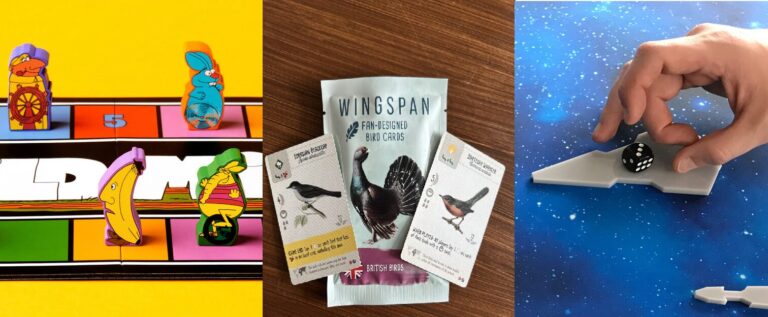
Small is beautiful: Fight in a Box’s Seppy Yoon on succeeding with small-scale crowdfunds, managing convention maths, and keeping up with the competition
Bigger money crowdfunding projects inevitably take up the lion’s share of discussion in board game circles, but the vast majority of projects inevitably run on a smaller scale – and with smaller margins for error. Managing production at that scale can be a significant challenge, but is one frequently faced by first-time designers and more established board game publishers alike. Seppy Yoon from board game publisher Fight In A Box has successfully managed a string of small Kickstarter projects – and one which failed to reach its goal. Amid raising funds for the company’s latest Kickstarter project, he shares his advice and insights on deciding how big your game should be, managing convention finances, and balancing creative urges with keeping a game project manageable.
This Box Is Too Big: Conquest Princess, Fashion is Power!
Conquest Princess: Fashion is Power is amazing. Critics and conventioneers love it! It’s my magnum opus as a game designer. But as a crowdfund, despite raising $50,000-plus across two campaigns, it has just 300-plus backers (some of whom were very board-game-famous). Princess failed to build up the Fight in a Box fan base proportional to the time commitment, having taken nine years to complete. It’s a great start to a great community, but as an indie, every time you start over it’s a financial risk. And a big box is a big risk!
Big boxes mean big everything: large minimum fund goals, highly vulnerable to shipping crises (like the one we’re in now), warehousing becomes an extra cost/concern: but maybe worst is it’s a big leap of faith for new fans. Crowdfunding’s biggest benefit for an indie game publisher is the opportunity to meaningfully engage and grow your community and fan base. All barriers to entry are in opposition to that goal. Price and unconventional themes can be big hurdles to overcome.
Building Audiences Where There Are None
Whenever you’re trying something too new, you’re practically starting over with building your fan base. Every time we’ve jumped to a new box format/size or game type, we’ve lost folks’ attention. Featuring all women and LGBTQ main characters is very new to modern board games, and yet another leap.
It’s hard to make games that include others, and being the first anywhere means that you’re not just building an audience for yourself, but also for people who don’t know that these games are for them. Not all choices that you make for creative endeavors are financial ones, but do have financial consequences.
The upsides to big box projects are twofold: you can spend a competitive amount of money per lead for marketing and during conventions, you can spend quality time with fans (more on this in the next section.)
This Box Is Too Small: Mouse Cheese Cat Cucumber
In May of 2020, we had a project we had to cancel. The Inevitable Machine Revolt was the expansion to our sold-out, cult-classic, End of the Line: Post-Apocalyptic Family Survival. In 2020, with everybody in lockdown, it was a terrible time to publish a game making fun of the end of the world.
We set the ambitious goal of $25,000 in a short 10-day campaign. With 212 backers and 3 days left, we canceled the project $7,500 short of the goal. We took this as a sign that our methodology for crowdfunding needed a massive update.
Without knowing what the world logistical situation might hold, we decided to change gears and instead add a third title to our small box series, while rebooting our Kickstarter process and expectations. Nine months later, we launched Mouse Cheese Cat Cucumber.
Building on the success of Squirrel or Die and Hedgehog Hop, Mouse Cheese Cat Cucumber was the third in our small box series. Being only 36 large format cards in a tuck box, the price point for Mouse Cheese made it a no-brainer for folks who like our previous titles. With lower risk and a smaller funding goal, this would be our bounce-back title from the Inevitable Machine Revolt.
You Shouldn’t Put an Epic in a Small Box
Being trapped [during the pandemic] like everyone else, we got a little carried away with making extras. The time spent on a title needs to be proportional to the financial gain, as well as being a creative expression. 500+ backers helped Mouse Cheese Cat Cucumber raise $26,000 on a $4,500 goal. With over 250 pages of extra content for a small box, we sort of lost our minds making Mouse Cheese Cat Cucumber the most overproduced $13.50 in gaming. The content added was for the smallest fraction of those 500 people.
Critics loved Mouse Cheese Cat Cucumber and it introduced a lot of new people to our small box series. The problem with the title arose when facing an uncertain gaming convention market. We sold Mouse Cheese as part of a bundle, but that meant also demoing the other games. Ultimately, we were spending 30 to 45 minutes demoing in a booth for potentially what was a $30 or $35 sale, and that’s very rough for convention math.
Mouse Cheese was a crowdfunding success and a distribution and retail success, but was a hard effort for convention going, which is our largest area for community growth. Not because the game isn’t great, but because conventions are expensive, and $13.50 is not a lot per sale.
For large conventions like Gen Con or PAX Unplugged, you need to be selling at least $350 per hour to break even on the total show cost. For our small box bundle, that means we would need to sell 12 bundles per hour. We would need to be demoing non-stop for 24 simultaneous gamers the entire convention. And cram that all into a 10×10 foot booth? Talk about a pickle!
This Box Would Have Been Just Right… But There’s A Corpse In It: End of the Line
We promised the fans of our 2016 game End of the Line: Post-Apocalyptic Family Survival that they would get something new after we finished Conquest Princess. That promised time is now! But let’s jump back eight months…
With three successful crowdfunds proving our methodology, we took a look at our sold out cult classic. But what we discovered was that although our marketing and communication style had gotten updated, the game itself was still something that was written in 2009. Modern gamers expect more fun, that is easier to learn, in a smaller amount of time, and the expansion alone did not bring the game up to those standards.
Enter End of the Line 2nd edition. There has been a lot of innovation in gaming and we’ve learned a lot as game designers and publishers in the last 15 years. We would be remiss to not apply that to this project. So before anything else, we decided on a box size that our fans were familiar with, that lowered the cost of entry for potential new fans, but we could still afford to demo at conventions (same price point as the Mouse Cheese bundle, one-third of the demo time).
Additionally, we streamlined the rules, making the game easier to learn and quicker to play. The new deadly drafting mechanic keeps the same kind of controlled-chaos-strategy-choices, simultaneous play, light programming and triumphant feel. While addressing previous soft spots in the design, it also added a passive-aggressive player-on-player interaction, which is dubiously fun.
Even If You’re Improving, Gaming Is Moving Faster Than Your Little Indie Legs Can Keep Up With
You can’t be shooting to catch up. You have to be looking to jump ahead. As we say in End of the Line: “First in line a gets a bonus. End of the line gets nothing.”
The magical jump ahead for this edition of End of the Line is the inclusion of the resource mascots: Gascan, Bullet, CanTina and Beans. The cartoon antics of these characters make the horrors of the Apocalypse a Looney Tune Adventure. We’re hoping this brings us success at the End of the Line.
The second edition of End of the Line: Post-Apocalyptic Family Survival is raising funds on Kickstarter until July 26.





